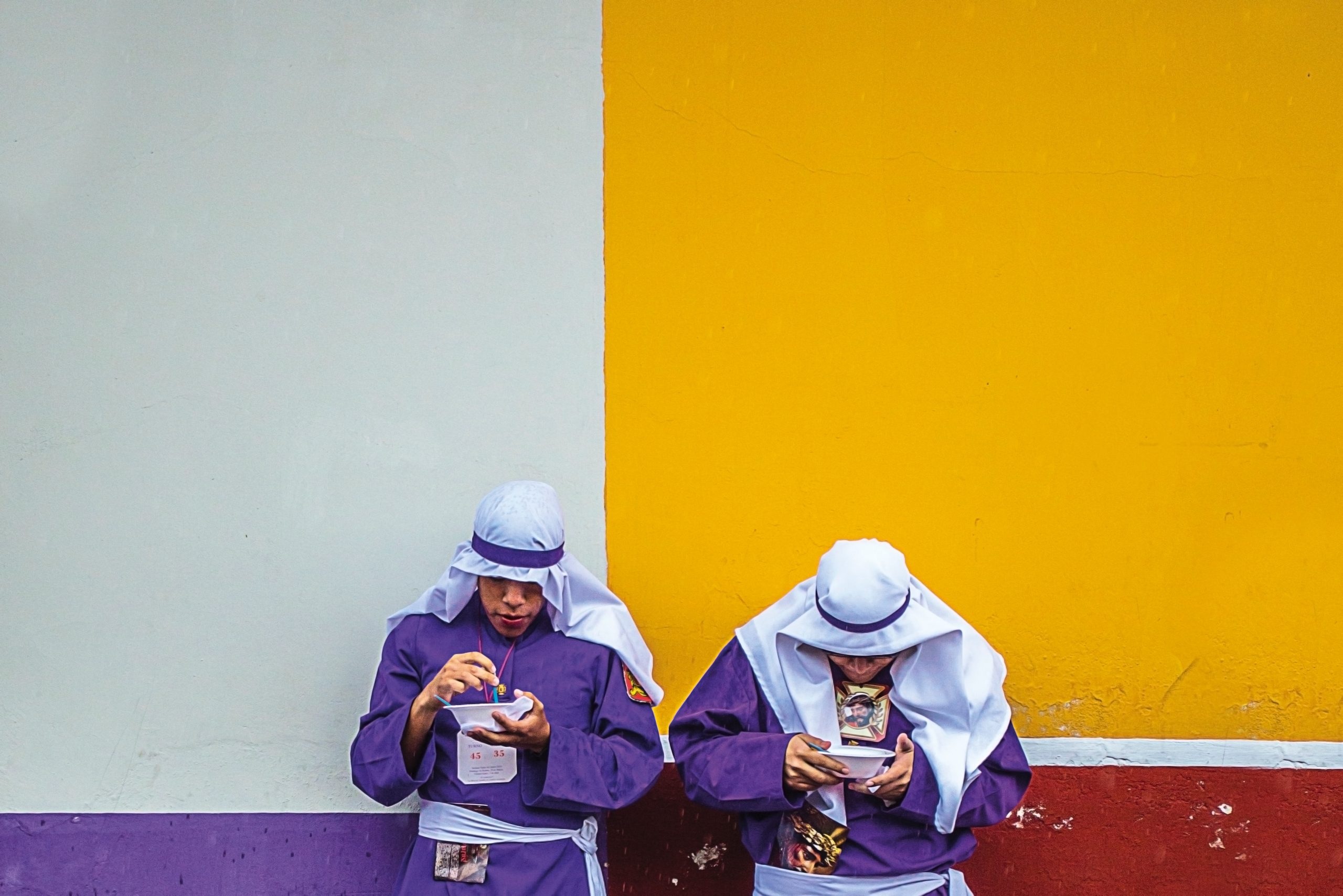My favorite food is pulique, a particular caldo (broth) that is typically made in Guatemala. Pulique is simply delicious, and it always makes me feel at home no matter where I am. There is also great meaning in this chicken broth, which is traditionally prepared during the Holy Week. It’s not just food; it represents a culture of devotion among the habitants of Santiago Atitlán.
The Traditions of Holy Week
Since Guatemala is mostly a Catholic country, one of the biggest holidays of the year is Holy Week before Easter. During this week, the entire country takes a break from work, school, and worldly pleasures. Holy Week is more than just a week without work—it is the week to remember Jesus and His victory over Satan and death.
Holy Week is a time of prayer and reflection, where people look to venerate the Santos (Saints) such as San Pedro, Mateo, and most importantly La Virgen María. Holy Week begins with Domingo de Ramos (Palm Sunday), and it ends with Domingo de Resurrección (Sunday of the Resurrection). The days of the week in between are mostly called Santo, or holy: Lunes Santo (Holy Monday), Martes Santo (Holy Tuesday), and so on. The most important day, though, is Viernes Santo (Good Friday), when the whole town faithfully watches a procesión (parade) that honors Christ and His suffering for our sins. Guatemala has the largest Easter procession in the world—the Cristo Yacente del Calvario (the Reclining Christ of the Calvary)—that walks the streets of the capital during the Holy Week. The Cristo Yacente del Calvario is considered the largest procession in the world because of its dimensions. The main platform—featuring a reclining Christ figure—is about 25 meters (82 feet) long, 2 meters (six-and-a-half feet) wide, approximately 1,134 kilograms (2,500 pounds), and is lifted each block by 140 people—that is, 280 arms. Devout Catholics usually pay to participate in the Viernes Santo procession, some paying as much as Q1,009 ($130) to take part—a token of faith and love towards Christ. But for me, Holy Thursday is my favorite day, as long as I spend it in Santiago Atitlán, a town in the region of Sololá, Guatemala.
Food Traditions
On Holy Thursday, the Last Supper is remembered and all the women in Santiago Atitlán make the same dish: pulique. Pulique is a reddish chicken broth made with ejote (green beans), potatoes, güisquil (Guatemalan squash), and carrots. The dish is often accompanied by rice and tortillas or tamalitos. Each family has a slightly different recipe for pulique, each with a unique flavor. The whole town is united in the tradition of making this special broth. The part that I love the most is that when the women finish making the dish, they share it with others. Each woman divides her pulique, puts some in a small pot, and visits her comadres, or close friends, to share her delicious broth. Usually, the Comadre will gift them bread in return for the pulique. This is in honor of the Last Supper that Christ had with His closest friends, the apostles. The friend, who also has pulique, accepts her friend’s broth and mixes it with hers so that at the end of the day, the pulique is a mix of all the friends’ broth. The whole town is nourished by this tradition, a tradition based on sharing just like Jesus did.
Pulique Recipe:
▶▶ 4 bone-in chicken breasts
▶▶ 9 small roma tomatoes or 4 big tomatoes
▶▶ . c fresh mint
▶▶ 2 cloves garlic
▶▶ 1 c flour
▶▶ 2 large carrots
▶▶ 10 small potatoes, peeled
▶▶ 3 c green beans
▶▶ 3 squash-type vegetables
▶▶ 4 c rice
▶▶ 2 avocados, sliced or mashed
▶▶ 4 c white rice
Tortillas:
▶▶ 1 c corn flour Maseca (you can find this in any Hispanic section at Walmart or in Latinx grocery stores)
▶▶ ⅔ c warm water
Instructions:
- Start 4 c of rice cooking on stovetop or in a rice cooker, then move on to broth while it cooks.
- Boil 3 c of water and salt it well. Add chicken breasts once the water reaches a rolling boil.
- Chop vegetables for the soup base. Halve tomatoes, crush garlic, and pull mint leaves off the stems.
- Add flour and crushed garlic to a dry frying pan on the stove. Toast until flour is a medium brown.
- Add prepared tomatoes, mint, garlic flour, and . c water to a blender and puree. If the mixture is too thin, add more tomatoes to thicken. Once mixture has reached the right consistency (slightly lumpy), add it to the boiling chicken.
- Now prepare the vegetables: peel carrots and slice into thin rounds. Peel potatoes and cut into bitesized pieces. Wash green beans, remove stems, and snap into 2–3 in sections. Wash squash, cut out stem, and dice.
- Add all the vegetables to the soup. Boil until chicken and potatoes are done, about 25 minutes.
- Meanwhile, make the tortillas. Mix 1 c flour with warm water; continue to add water until the dough sticks together well. Grab a handful of dough, roll it into a ball, flatten it in between your palms, and cook on medium heat until each side begins to brown.
- Serve broth over rice, topped with sliced or smashed avocados. Enjoy tortillas on the side!
—Melina Anderson Gálvez

